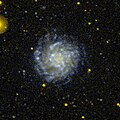| NGC 5668 | |
|---|---|
 NGC 5668 imaged by the Hubble Space Telescope | |
| Observation data (J2000 epoch) | |
| Constellation | Virgo |
| Right ascension | 14h 33m 24.331s [1] |
| Declination | +04° 27′ 01.75″ [1] |
| Redshift | 0.005280 |
| Heliocentric radial velocity | 1,582 ± 5 [2] km/s |
| Distance | 80.9 ± 5.5 million light years (24.8 ± 1.7 Mpc) [2] |
| Group or cluster | NGC 5638 Group, NGC 5746 Group, Virgo III Groups |
| Characteristics | |
| Type | SA(s)d [2] |
| Mass | 5.7×1010 [2] M☉ |
| Size | ~48,400 ly (14.84 kpc) (estimated) |
| Apparent size (V) | 3.0′ × 3.0′ |
| Other designations | |
| IRAS 14309+0440, UGC 9363, MCG +01-37-028, PGC 52018, CGCG 047-090 [3] | |
NGC 5668 is a nearly face-on spiral galaxy, visual magnitude about 11.5, [4] located about 81 [2] million light years away in the constellation Virgo. It was discovered on 29 April 1786 by William Herschel. [4]
Contents
NGC 5668 is a member of the NGC 5638 Group of galaxies, itself one of the Virgo III Groups strung out to the east of the Virgo Supercluster of galaxies. [5] In addition, A.M. Garcia listed NGC 5668 in the 31 member NGC 5746 galaxy group (also known as LGG 386). [6]
As seen from the Earth, it is inclined by an angle of 18° to the line of sight along a position angle of 145°. The morphological classification in the De Vaucouleurs system is SA(s)d, [2] indicating a pure spiral structure with loosely wound arms. [7] However, optical images of the galaxy indicate the presence of a weak bar structure spanning an angle of 12″ across the nucleus. There is a dwarf galaxy located around 650×103 ly (200 kpc) to the southeast of NGC 5668, and the two may be gravitationally interacting. [2]

